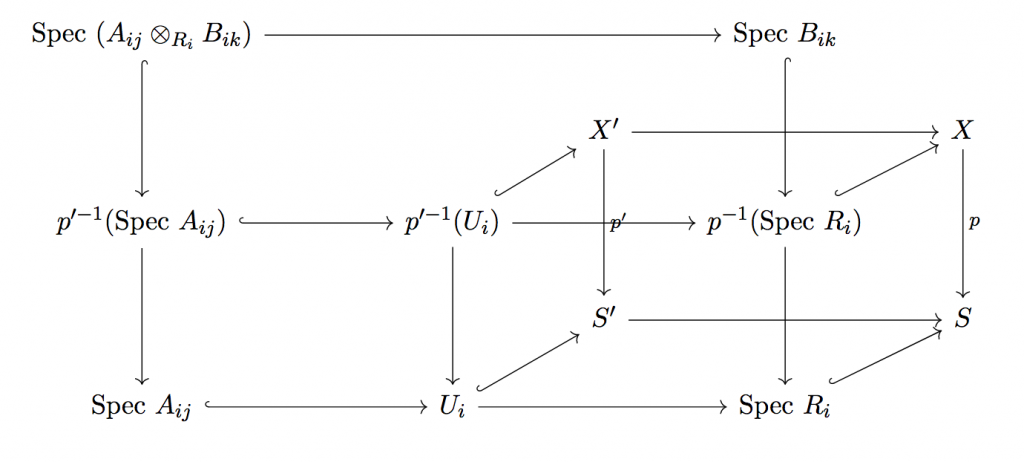Previously we showed that morphisms locally of finite type are preserved under base change. We can use this to show that
![]() Given a morphism of schemes
Given a morphism of schemes ![]() , the preimage of any affine
, the preimage of any affine ![]() can be covered by affines such that the corresponding ring maps are of finite type.
can be covered by affines such that the corresponding ring maps are of finite type.
Alternatively, if we define a morphism locally of finite type to be one that satisfies ![]() , then what we are saying is that such a property can be checked on a cover; we can replace “any affine” with “an affine in a cover of affines”.
, then what we are saying is that such a property can be checked on a cover; we can replace “any affine” with “an affine in a cover of affines”.
Let’s try to prove ![]() . First, we base change to
. First, we base change to ![]() . Since the morphism
. Since the morphism ![]() is also locally of finite type, we can cover
is also locally of finite type, we can cover ![]() by affines
by affines ![]() such that their preimages can be covered by the spectra of finitely-generated
such that their preimages can be covered by the spectra of finitely-generated ![]() -algebras
-algebras ![]() . However, we don’t know if these are finitely-generated
. However, we don’t know if these are finitely-generated ![]() -algebras! To fix this, we base change to even smaller affines. Cover
-algebras! To fix this, we base change to even smaller affines. Cover ![]() by basic open sets
by basic open sets ![]() . This gives us a cover of each
. This gives us a cover of each ![]() by basic open sets of the form
by basic open sets of the form ![]() . Since
. Since ![]() is of finite type,
is of finite type, ![]() is of finite type. Since
is of finite type. Since ![]() is clearly of finite type,
is clearly of finite type, ![]() is of finite type, giving us the desired cover of
is of finite type, giving us the desired cover of ![]() . The following diagram may be illustrative (every square is a pullback)
. The following diagram may be illustrative (every square is a pullback)


![Rendered by QuickLaTeX.com \xymatrix{R\ar[r]^{\phi}\ar[d]^{\phi} & {R[t^\pm]} \ar[d]^{id_R\otimes \mu}\\{R[u^\pm]} \ar[r]^{\phi \otimes id_{k[u^\pm]}} & {R[t^\pm, u^\pm]}}](https://www.ocf.berkeley.edu/~rohanjoshi/wp-content/ql-cache/quicklatex.com-be58b01614e66fda49f67e15ebbc62ce_l3.png)
![Rendered by QuickLaTeX.com \xymatrix{R\ar[r]^{\phi}\ar[d]^{id_R} & {R[t^\pm]} \ar[dl]^{i}\\ R}](https://www.ocf.berkeley.edu/~rohanjoshi/wp-content/ql-cache/quicklatex.com-328480c25d8ee63a186221bdc075521c_l3.png)